Welcome to Club Cobra! The World's largest
non biased Shelby Cobra related site!
- » Representation from nearly all
Cobra/Daytona/GT40 manufacturers
- » Help from all over the world for your
questions
- » Build logs for you and all members
- » Blogs
- » Image Gallery
- » Many thousands of members and nearly 1
million posts!
YES! I want to register an account for free right now!
p.s.: For registered members this ad will NOT show
 
 Main Menu
Main Menu
|
 Nevada Classics
Nevada Classics
|
 Advertise at CC
Advertise at CC
|
 March 2025
March 2025
|
| S |
M |
T |
W |
T |
F |
S |
| |
|
|
|
|
|
1 |
| 2 |
3 |
4 |
5 |
6 |
7 |
8 |
| 9 |
10 |
11 |
12 |
13 |
14 |
15 |
| 16 |
17 |
18 |
19 |
20 |
21 |
22 |
| 23 |
24 |
25 |
26 |
27 |
28 |
29 |
| 30 |
31 |
|
|
|
|
|
|
 CC Advertisers
CC Advertisers
|
|
 2Likes 2Likes

07-02-2007, 06:34 PM
|
 |
CC Member

|
|
|
Join Date: Mar 2001
Location: Provo,
Ut
Cobra Make, Engine: Kirkham, 427
Posts: 6,990
|
|

 Not Ranked
Not Ranked
Bottom shot of the differential installed.

Last edited by David Kirkham; 07-02-2007 at 06:53 PM..
|
-
Advertising


07-02-2007, 06:36 PM
|
 |
CC Member

|
|
|
Join Date: Mar 2001
Location: Provo,
Ut
Cobra Make, Engine: Kirkham, 427
Posts: 6,990
|
|

 Not Ranked
Not Ranked
place holder
|

07-02-2007, 06:38 PM
|
 |
CC Member

|
|
|
Join Date: Mar 2001
Location: Provo,
Ut
Cobra Make, Engine: Kirkham, 427
Posts: 6,990
|
|

 Not Ranked
Not Ranked
placeholder
|

07-02-2007, 06:47 PM
|
 |
CC Member

|
|
|
Join Date: Mar 2001
Location: Provo,
Ut
Cobra Make, Engine: Kirkham, 427
Posts: 6,990
|
|

 Not Ranked
Not Ranked
another place
|

07-02-2007, 06:51 PM
|
 |
CC Member

|
|
|
Join Date: Mar 2001
Location: Provo,
Ut
Cobra Make, Engine: Kirkham, 427
Posts: 6,990
|
|

 Not Ranked
Not Ranked
place holder
for the diff
|

07-02-2007, 07:00 PM
|
 |
CC Member

|
|
|
Join Date: Mar 2001
Location: Provo,
Ut
Cobra Make, Engine: Kirkham, 427
Posts: 6,990
|
|

 Not Ranked
Not Ranked
more diff stuff
|

07-02-2007, 07:19 PM
|
 |
CC Member

|
|
|
Join Date: Mar 2001
Location: Provo,
Ut
Cobra Make, Engine: Kirkham, 427
Posts: 6,990
|
|

 Not Ranked
Not Ranked

INSTALLING THE FLYWHEEL, TRIMMING THE BELL HOUSING, AND DIALING IN THE BELL HOUSING.
First, a note from the legal department.
We like to install scatter shields in our personal rides. Since our feet extend past the clutch plate, we like to have something more than a cast aluminum bell housing between our legs and the spinning flywheel/clutch setup.
This information is provided only to let you know what we have tried and found mentally comforting. Anyone contemplating modifying their own scatter shield should read DISCLAIMER OF WARRANTY and the important safety tips.
DISCLAIMER OF WARRANTY: As with so many other things in life, what you do here is at your own risk. Kirkham Motorsports is providing this information only to let people know what we do with our own personal stuff. Kirkham Motorsports isn't responsible if you have problems before, during or after this warranty-voiding modification.
Modifying your scatter shield may kill, injure, harm, upset, or otherwise cause problems to you, passers by, pets, government officials, race sanctioning bodies, and others. Please check local laws, race sanctioning bodies, and anyone else who might have a competent opinion before undertaking the modifications listed above.
It is likely you will use dangerous tools to perform the above modifications. Please insure that all tool safety equipment is in place before attempting any modifications. For your own safety, it would be best to hire someone competent and experienced to modify your scatter shield for you.
Lakewood makes a very fine scatter shield which can be installed after trimming. On the down side, the modifications on this page will probably void whatever warranty your scatter shield may have had. Furthermore, common sense says any cuts made to the scatter shield will probably weaken it, though it should still be better than a cast aluminum bell housing (which we wouldn't ever use). Obviously, any modifications you make to the scatter shield are at your own risk.
If you still want to modify your scatter shield/bell housing, this is how we do it:
The first thing you have to do is trim the bell housing. As the bell housing comes out of the box, it will not fit in a our car...or, by extension an original Cobra. The bell housing must be notched to clear the right frame rail next to the starter. Also, JUST AS IMPORTANT, you need to cut the bottom of the bell housing off so it will clear any object you happen to run over...like rocks, weeds, cats, road gators, Osama's buddies, speed bumps, and THE WORST OFFENDER--TRAILERS (this is where LOTS of cars get high centered).
Here Sandwich is getting ready to cut the offending parts of the bell housing off. He will cut the bell housing along the black lines he has drawn on the bell housing. You can get a pattern for doing your own cutting off of our website under the "Technical FAQ's."

Here is Sandwich on the band saw. Notice he is wearing his SAFETY GLASSES! You should too! I once had a piece of crap fall in my eye when I opened a hood and then wondered why my eye started to feel like it was on fire the next day. Well, I had to have the local eye surgeon scrape the crap out with a needle. It was one of the most painful experiences I have ever had in my entire life! On the bright side, the surgeon is now a very good friend of mine and did Lasik on my eyes and now I can see way better than 20/20. He is an incredible doc, Thanks Doctor Noble!
Notice Sandwich bolted the backing "saver" plate to the bell housing so he could save time and cut them together and make a neat cut.

Last edited by David Kirkham; 07-03-2007 at 09:18 AM..
|

07-02-2007, 07:21 PM
|
 |
CC Member

|
|
|
Join Date: Mar 2001
Location: Provo,
Ut
Cobra Make, Engine: Kirkham, 427
Posts: 6,990
|
|

 Not Ranked
Not Ranked

Now we are going to install the flywheel BUT, you HAVE to install the engine "saver" plate FIRST...it goes in front of the flywheel (in front of meaning toward the front of the car). Just think, I have just saved you 1/2 hour of all sorts of bad words and thrown wrenches because you probably would have just bolted the flywheel on in your excitement and forgot the "saver" plate. Then you would have had the wonderful opportunity of taking everything back off again and cleaning out all the yucky Locktite that got stuck in the holes. On the bright side, you could have practiced your technique torquing your flywheel bolts...
I am not sure why they call it a "saver" plate because if your flywheel/clutch explodes I am not sure there would be anything left on the block worth saving. But, fortunately, I haven't seen--or heard--of a blown clutch/flywheel since we have been in business. In the early 60's the big three ran cast grey iron flywheels. I have heard they blew up all the time at the drags. In the mid 60's they changed to ductile iron and that stuff is almost indestructible. Not sure if any of those ever blew up. But drag racing started way before the 60's and the rules got made and now we still live by them even though our materials are VASTLY superior to what they ran back in the day. (Come to think of it, we suffer the same problem with Congress. Like Mark Twain said, "The only time a man's life, liberty, and property are all in jeopardy is when the legislature is in session.")
I digress,
Back to the "saver" plate.
The plugs on the back of the motor do NOT sit flush with the back of the motor. The stick out. They will interfere with installing the "saver" plate. So, you have to drill relief holes for them. There are two holes you have to drill. One is here:

And the other is here: In this picture, Sandwich has already drilled the hole out. To mark the holes, we simply put magic marker, chalk, or anything else that happens to be within reach and cover the offending plug. We then put the plate on and lightly tap the plate over the plugs. We then have a beautiful mark where to drill the holes.

Yes, I have seen people just bolt the plate down and dent the plate. If your mechanic wants to do that, just STOP, blow the whistle, and tell him, "STEP AWAY FROM THE CAR!"
Last edited by David Kirkham; 07-03-2007 at 09:26 AM..
|

07-02-2007, 07:31 PM
|
 |
CC Member

|
|
|
Join Date: Mar 2001
Location: Provo,
Ut
Cobra Make, Engine: Kirkham, 427
Posts: 6,990
|
|

 Not Ranked
Not Ranked
Now we need to find the bolts to bolt on the flywheel. We ONLY use ARP flywheel bolts. Critical bolts are one of those things that you don't want to skimp on. It takes a LOT of work to dial in a bell housing and there is no sense "testing" the scatter shield to see if it "works." 
I forgot to take the picture of the bolts before Sandwich took them out of the package, but here is the package anyway. Flywheel bolts for a Ford FE are ARP part number 200-2802.

And here they are holding on the flywheel. We use Blue Locktite and CLEAN OUT THE HOLES with brake clean! Like most people, Locktite doesn't like to work when it is dirty. We torque the flywheel bolts to 80 ft/pounds. Notice we use an aluminum flywheel. I HATE steel flywheels! The motor takes WAY too long to rev and which makes canyon driving much less enjoyable.

Last edited by David Kirkham; 07-03-2007 at 09:28 AM..
|

07-02-2007, 07:33 PM
|
 |
CC Member

|
|
|
Join Date: Mar 2001
Location: Provo,
Ut
Cobra Make, Engine: Kirkham, 427
Posts: 6,990
|
|

 Not Ranked
Not Ranked

And now we run into our first major problem! I should have known the FE gods were going to get me back when dialing in the bell housing was so easy (see below). We actually put the pilot bearing in after we dialed in the bell housing but it doesn't matter when you do it.
Anyway, the hole in the Scat crankshaft is TOO BIG! It was machined wrong by Scat. When we tried to put the pilot bearing in--it just FELL in. The hole in the crank measured 1.860 inches and the bearing measures 1.852 inches. Thinking we need about a 0.002 inch interference fit, that means the crank was machined 0.010 inches over sized.

So, the master machinist Sandwich trimmed 0.200 inches off the outside diameter of the pilot bearing and then machined an aluminum sleeve to go over the outside of the bearing and bring it back up to the proper 1.862 inch outside diameter. Sandwich is to the lathe what Jason Bell is to a Stradivarius.

Here is the pilot bearing we use: Part number SKF B50-HD Sorry the picture is blurry, but the box is blurry.

Last edited by David Kirkham; 07-03-2007 at 10:58 AM..
|

07-02-2007, 07:36 PM
|
 |
CC Member

|
|
|
Join Date: Mar 2001
Location: Provo,
Ut
Cobra Make, Engine: Kirkham, 427
Posts: 6,990
|
|

 Not Ranked
Not Ranked

Now, for the thing we always get a million questions on. Dialing in a bell housing. You may ask, "Why do I need to dial in my bell housing?" Good question. The bell housing is what holds the transmission on to the engine. The center of the transmission input shaft is supposed to be pointed directly at the center of the crankshaft. There is a pilot bearing/bushing in the end of the crankshaft. The bearing or bushing can be a true needle bearing, or it can be made out of bronze.
The snout on the input shaft of the transmission fits very snugly into the bearing/bushing. If they are not "perfectly" in line then the input shaft on the transmission will be cocked over and the bearing on the input shaft will start screaming it is UNHAPPY! Well, in a very short time, you will be unhappy too as you have to pull your interior, seats, tunnel, emergency brake cable, throw out bearing assembly, drive shaft, and drive shaft safety loop--for those of you who were smart and bought that option. (Nothing like a free wheeling drive shaft by the family jewels to give you an unexpected vasectomy if it unexpectedly comes loose or apart. But hey, look at the bright side--if it broke it'll probably be sharp, so it'll be quick--but probably not too painless...).  Anyway, it is about a 4 hour job to fix everything--(the tranny, that is, not the neutering). Signs of a bad alignment on the bell housing are: hard shifting, noisy front bearing, and if you are really unlucky, a complete failure of the bearing with lots of little metal parts scattered in your transmission.
So, to avoid purchasing stock in the antacid companies, please dial in your bell housing or have someone who is competent do it--I have seen several that are NOT competent. The current "record" is actually from a "professional" installer--0.139" out! That is more than 1/8 of an inch! The bearing didn't last 100 miles, but that was more than the warranty the installer gave and the customer was left out in the cold. The car ended up here where so many of them do that have had Backyard Bob working on them--right here back in our shop for a "tune up."
First thing to do is drill the dowel pin holes over sized in the bell housing--we drill them to 1/16 inch larger than the bushings we are going to weld in. Sandwich is kindly pointing to the 2 holes that need to be drilled out. They are circled with black magic marker.

Last edited by David Kirkham; 08-03-2007 at 09:36 PM..
|

07-02-2007, 08:10 PM
|
 |
CC Member

|
|
|
Join Date: Mar 2001
Location: Provo,
Ut
Cobra Make, Engine: Kirkham, 427
Posts: 6,990
|
|

 Not Ranked
Not Ranked
Then you will need to buy (or make as we usually do) these babies. Here are the weld bushings we use.
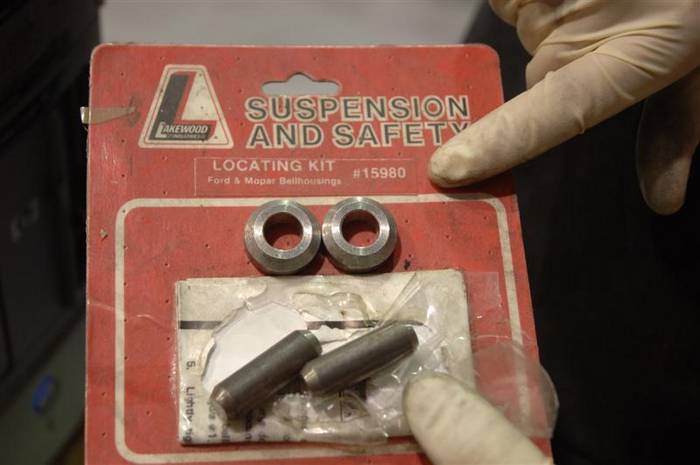
Last edited by David Kirkham; 07-03-2007 at 06:49 AM..
|

07-02-2007, 08:15 PM
|
 |
CC Member

|
|
|
Join Date: Mar 2001
Location: Provo,
Ut
Cobra Make, Engine: Kirkham, 427
Posts: 6,990
|
|

 Not Ranked
Not Ranked
Then you need to bolt on your bell housing on to the back of the motor. We use Socket Head Cap Screws (Allen bolts) because they offer a lot more clearance. If you use a normal hex bolt you will NOT be able to tighten up the bolts with a normal socket as the bell housing is formed too close to the holes. Notice how we do NOT have washers under the head of the bolts. We ALWAYS put washers under the head of all bolts, but here we are about to adjust the bell housing and they may get in the way. Some bell housings have to move a LONG way. We will install the washers when we are done dialing in the bell housing. Also, notice that we have put the weld bushing in place over the dowels in the engine block. There is about 0.030 inch clearance all the way around between the bushings and the bell housing to give us enough clearance to move things around. The idea here it to get the hole in the bell housing centered with the center of the crank.

Last edited by David Kirkham; 07-03-2007 at 06:51 AM..
|

07-02-2007, 08:19 PM
|
 |
CC Member

|
|
|
Join Date: Mar 2001
Location: Provo,
Ut
Cobra Make, Engine: Kirkham, 427
Posts: 6,990
|
|

 Not Ranked
Not Ranked
***NOTE***
You need to pull your spark plugs out of your motor when you do this to make turning the engine over easier. Of course, you may want to get a workout...
Stick your dial indicator--only about $15 (made in China) to $50 (made in USA) on to the flywheel. Dial indicators have a magnetic base. We cut the stand to make it easier to put into the bell housing hole as we do this every so often.
Now for something that is not so obvious. IT DOESN'T MATTER WHERE YOU STICK THE DIAL INDICATOR ON THE FLYWHEEL!!! They flywheel moves in a circle and so will your dial indicator. Just adjust it so it points toward the edge of the bell housing and you will be OK.
Set the dial to 0 facing straight up.

Last edited by David Kirkham; 07-03-2007 at 04:08 PM..
|

07-02-2007, 08:22 PM
|
 |
CC Member

|
|
|
Join Date: Mar 2001
Location: Provo,
Ut
Cobra Make, Engine: Kirkham, 427
Posts: 6,990
|
|

 Not Ranked
Not Ranked
Turn the crank 90 degrees and read the indicator.
Here, we are only 0.001 out. That is REALLY good. That NEVER happens. Oh well, must be our lucky day. Write 0 on the top of the bell housing (because we forgot to in the previous photo) and write 1 (or one thousandth of an inch) at the 90 degree mark. You better write it down or you will end up chasing your tail.
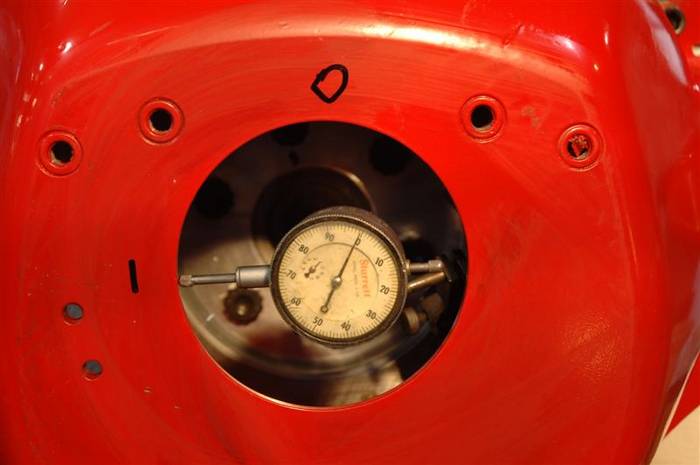
Last edited by David Kirkham; 07-03-2007 at 06:54 AM..
|

07-02-2007, 08:24 PM
|
 |
CC Member

|
|
|
Join Date: Mar 2001
Location: Provo,
Ut
Cobra Make, Engine: Kirkham, 427
Posts: 6,990
|
|

 Not Ranked
Not Ranked
Turn the flywheel 90 degrees and write down the number. Here it is -0.006" so we write a 6 on the bell housing. Come to think of it, we SHOULD have written "-6" on the bell housing, but this is a case of not seeing the forest for the trees. We dial things in all day long so we just remember things, not realizing we can lose other people pretty quickly.
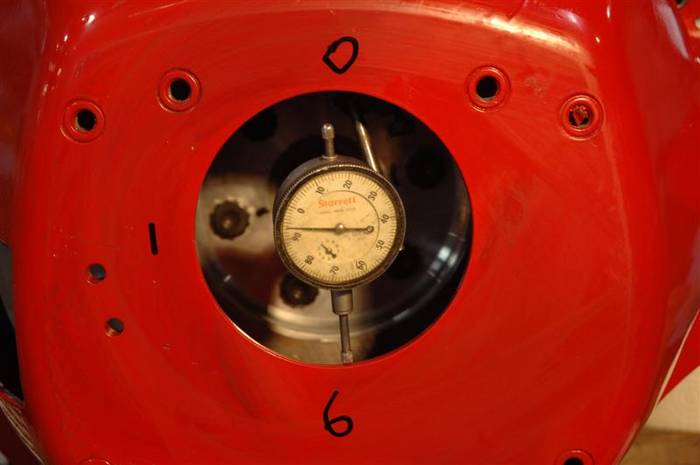
Last edited by David Kirkham; 08-03-2007 at 09:37 PM..
|

07-02-2007, 08:27 PM
|
 |
CC Member

|
|
|
Join Date: Mar 2001
Location: Provo,
Ut
Cobra Make, Engine: Kirkham, 427
Posts: 6,990
|
|

 Not Ranked
Not Ranked

Turn the crank 90 degrees again and read the number. Here it is +0.003 inches so we write a 3 on the bell housing. So, you can see we are -6 and +3 out in the lower right hand corner (in the photo) of the bell housing. So, we need to move the bell housing up and to the right. The easy way to remember how to move the bell housing is to always move it TOWARD the highest positive numbers. 3 is bigger than 1 so I want to move it toward the 3 (which is AWAY from the indicator--thus making the indicator read a LESSER number.) This is a little confusing, but you will get it if you think about it. Remember the 6 is actually negative and so it is SMALLER than the 0 so you want to move AWAY from the -6 and toward the 0--so, you want to move the bell housing UP.
The bell housing needs to be centered to within 0.005 TIR or Total Indicator Reading. This reading is 0.006 TIR in the up and down axis and 0.003 in the right and left axis. We try to get them to 0.002-0.003 TIR. So we will move the bell housing slightly.

Last edited by David Kirkham; 07-03-2007 at 10:37 AM..
|

07-02-2007, 08:38 PM
|
 |
CC Member

|
|
|
Join Date: Mar 2001
Location: Provo,
Ut
Cobra Make, Engine: Kirkham, 427
Posts: 6,990
|
|

 Not Ranked
Not Ranked

We moved the bell housing and re-did the measurements. This is what we came up with. You can see we got it down to 0.003 TIR. This time I was smarter and remembered to write down any negative numbers...but we didn't have any as all readings turned out to be on the positive side of the indicator this time.

There was a great question asked on the other thread and here is some supplemental material.
"I would like to know what sandwich used to drill out the dowel pin holes with, since I believe they need to be accurate holes. Did he use a drill press or just a hand drill. Are these holes real critical. And do you weld the dowel pin bushings in after your final centering of the bell housing. I assume that once this has been done the first time that removing the bell housing to replace clutch etc. will be centered the next time it is put back on the engine."
We actually used a mill, but a drill press (or even by hand) would be fine as they do not need to be too accurate.
Yes, you must weld the dowel pin bushings AFTER the final centering. It can get very tricky as the bell housing will move around while you are tightening it. It can really try your patience. Yes, the bell housing will stay aligned forever...well, at least until someone line bores the crank journals which is what screws up the alignment in the first place--especially watch out for original blocks.
We just used an standard 1 1/16 drill. The bushings are 1 inch in diameter. They do not need to be that accurate because they have 0.030 inches (1/32 inch) of clearance around the hole anyway. You will weld in the slight gap.
I should mention here, there are offset dowel pins that are available from Lakewood. We have found that very few engines are within the adjustability of the pins, so we just drill holes and use the weld bushings. I must say, however, that lately the engines have been better than they ever have been before. So, there is a very good possibility you could just use the pins and not have to weld. I know that would be a better option for many of you guys.
That said, the dowels in the engine block can be almost impossible to remove. When they are particular pigs, we cut them off flush with the block, drill a 1/4 inch hole in them (the dowels are 1/2 inch in diameter) and then weld the hole up. The combination of heat and shrinkage allows you to pull the pin out. (Welding creates heat which expands the metal. When you weld it up, the metal cools off and shrinks--way more than you think it would.) Usually, the dowel will just fall out. If it is still stuck, we weld a bolt on to the cut off dowel and then pull it out. Some can really try your patience (and vocabulary).
Last edited by David Kirkham; 07-03-2007 at 04:39 PM..
|

07-02-2007, 08:41 PM
|
 |
CC Member

|
|
|
Join Date: Mar 2001
Location: Provo,
Ut
Cobra Make, Engine: Kirkham, 427
Posts: 6,990
|
|

 Not Ranked
Not Ranked
Now comes the TRICKY part. You need to make sure your bell housing is bolted down TIGHT so that it can not move. When you bolt it down tightly, you need to check AGAIN with the dial indicator to make sure it HASN'T moved as you tightened it up. Then, simply weld the bushings into place. Your bell housing is now "dialed in." Time for another cold drink!
 |

07-03-2007, 07:03 AM
|
 |
CC Member

|
|
|
Join Date: Mar 2001
Location: Provo,
Ut
Cobra Make, Engine: Kirkham, 427
Posts: 6,990
|
|

 Not Ranked
Not Ranked
Now you need to take off the bell housing and bolt on the clutch and pressure plate. An old input shaft from a transmission is the BEST tool possible to line up a clutch. One of the BIG problems with the cheap plastic lining up tools is they do not fit very tightly into the pilot bearing. So, the weight of the clutch and pressure plate tends to bend the plastic line up tool and then you have a hard time getting the transmission to go in.
First item of business is to find the pressure plate bolts. Again, we use ARP 150-2201 bolts.
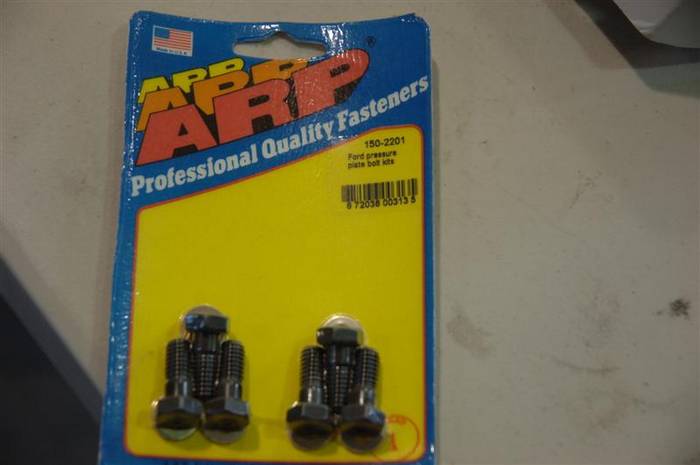
Last edited by David Kirkham; 07-03-2007 at 10:44 AM..
|
 Posting Rules
Posting Rules
|
You may not post new threads
You may not post replies
You may not post attachments
You may not edit your posts
HTML code is Off
|
|
|
All times are GMT -7. The time now is 06:33 PM.
|
|










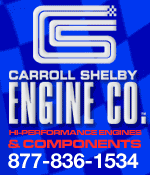
 2Likes
2Likes






 Anyway, it is about a 4 hour job to fix everything--(the tranny, that is, not the neutering). Signs of a bad alignment on the bell housing are: hard shifting, noisy front bearing, and if you are really unlucky, a complete failure of the bearing with lots of little metal parts scattered in your transmission.
Anyway, it is about a 4 hour job to fix everything--(the tranny, that is, not the neutering). Signs of a bad alignment on the bell housing are: hard shifting, noisy front bearing, and if you are really unlucky, a complete failure of the bearing with lots of little metal parts scattered in your transmission. Linear Mode
Linear Mode



